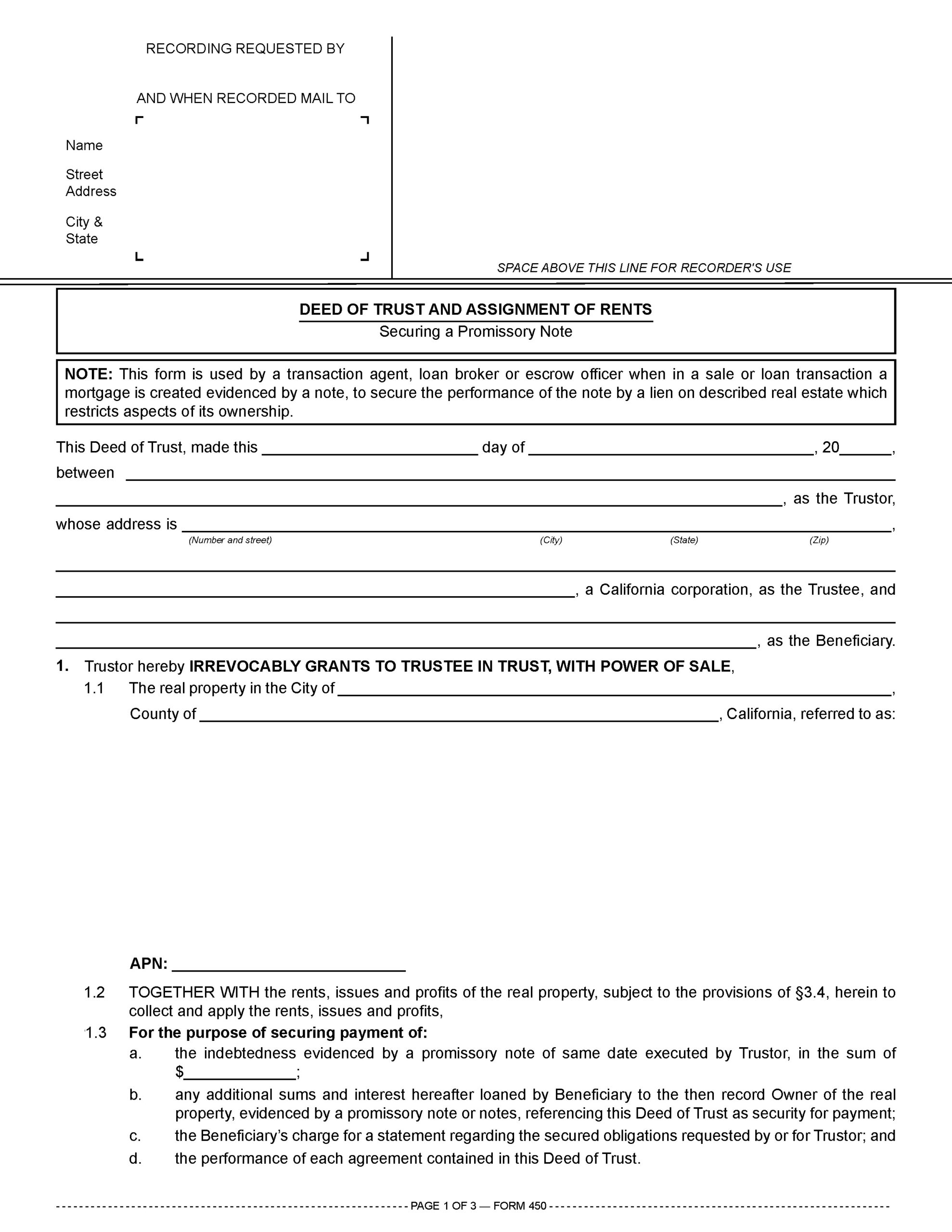This form is used by a transaction agent, loan broker or escrow officer when in a sale or loan transaction a mortgage is created evidenced by a note, to secure the performance of the note by a lien on described real estate which restricts aspects of its ownership.

Limiting mortgage holder interference
Provisions of a trust deed allow private lenders and carryback sellers to contractually restrict as many aspects of ownership and possession of the liened property as they can control. Restrictions provide reasons, enforceable or not, for exacting further profits from the ownership of the encumbered property.
At first glance, the list of rights given to a private lender or carryback seller, also known as a mortgage holder, seems to authorize their use of tremendous discretionary powers over activity normally conducted and of concern only by owners holding the beneficial use of the liened real estate.
For example, trust deeds routinely purport to give the mortgage holder the unhindered ability to:
- automatically accelerate the balance of the mortgage on the transfer of any interest in the property, such as an owner’s sale, further encumbrance, lease for a term greater than three years or a lease couple with a purchase option, called a due-on clause;
- determine the allocation of eminent domain proceeds after a condemnation action;
- apply all fire insurance proceeds to the mortgage balance; and
- call the mortgage when it or any other loan between the parties is in default, called a dragnet clause.
Fortunately for owners of property encumbered with a trust deed lien, California law unequivocally curbs the mortgage holder’s ability to strictly enforce discretionary provisions, as well as many other clauses which appear in some trust deeds. [See RPI e-book Real Estate Finance, Chapter 13]
For a start in this review, trust deeds are recognized as adhesion contracts. Here, one person or participant (the lender) has superior bargaining power over a weaker person (the borrower), usually on a “take it or leave it” basis.
A prospective borrower typically has no power to negotiate better terms with any lender than to agree to the boilerplate provisions in regular trust deeds, with the lender adamant that “sorry – it’s my way or no way.” The printed terms of the trust deed without deletion will be adhered to by the borrower when arranging financing, no questioning of the provisions.
This distinct imbalance in bargaining power led California courts to develop special adhesion contract rules for interpreting rights and obligations under uniform trust deeds used exclusively throughout the mortgage banking industry. These special rules are a judicial step toward limiting the collective dominance of lender bargaining power and interference, always for extra profits. [Steven v. Fidelity and Casualty Company of New York (1962) 58 C2d 862]
Trust deed provisions
Enforceable provisions found in a standard trust deed used to secure the performance of a note include:
- condition of property;
- hazard insurance;
- attorney fees;
- taxes and senior encumbrances;
- acts and advances to protect the security;
- assignment of damages;
- waiver;
- due-on-sale;
- assignment of rents;
- acceleration;
- trustee’s sale;
- trustor’s offset statement;
- special use agreements;
- reconveyance;
- successors, assigns and pledgees; and
- trustee’s foreclosure notices. [See RPI Form 450]
Analyzing the trust deed
A transaction agent, loan broker or escrow officer uses the Deed of Trust and Assignment of Rents — Securing a Promissory Note published by Realty Publications, Inc. (RPI) when in a sale of property or a loan transaction a mortgage is created as a device to secure a debt evidenced by a note. The trust deed form describes the property securing the performance of the note which by its provisions restrict use of ownership rights in the property. [See RPI Form 450]
The Deed of Trust and Assignment of Rents — Securing a Promissory Note contains:
- the date, identities of the trustor, trustee and beneficiary and address affected by the trust deed [See RPI Form 450];
- the city, county and description of the real estate irrevocably granted to the trustee, and the amount of indebtedness [See RPI Form 450 §1];
- trustor agreements [See RPI Form 450 §2];
- mutual agreements [See RPI Form 450 §3];
- addenda, such as the owner-occupancy rider and all-inclusive trust deed addendum [See RPI Form 450 §4; See RPI Form 202-3; See RPI Form 442 and 443];
- a reconveyance agreement [See RPI Form 450 §5];
- a successors, assigns and pledgees agreement which binds all participants and their heirs [See RPI Form 450 §6];
- trustee’s foreclosure notices certifying a notice of default and notice of sale will be mailed to the trustor at their listed address [See RPI Form 450 §7]; and
- the signature of the trustor. [See RPI Form 450]
A notary public then verifies the identity of the trustor and acknowledges the signature – notarizes – on the document so it can be recorded as acceptable by the County Recorder’s Office for public notice.
Form navigation page published 12-2023.
Form-of-the-Week: Deed of Trust & Assignment of Rents, and All-Inclusive Trust Deed Addendums — Forms 450, 442 and 443
Form-of-the-Week: All-Inclusive Trust Deed (AITD), AITD Addendum with Equity Payoff and AITD with Full Payoff —Forms 421, 442 and 443
Article: A trust deed investment for groups
Article: Rising rates bring back seller financing
Reading: Carryback financing – securing alternatives for buyers and sellers
Video: The Note and Trust Deed Work Together
Video: Who Conducts the Sale?
Video: Repayment Variations: Graduated Payment Mortgage and All-Inclusive Trust Deed










